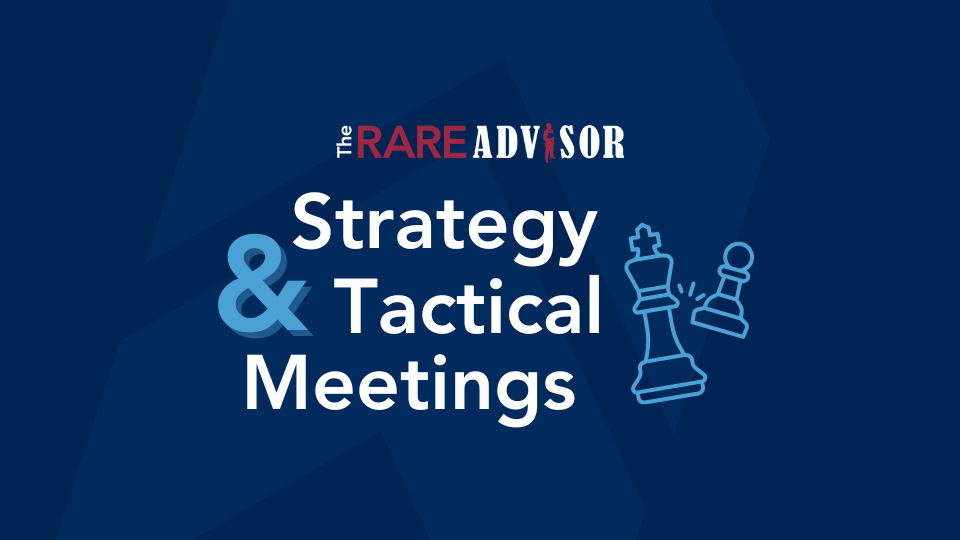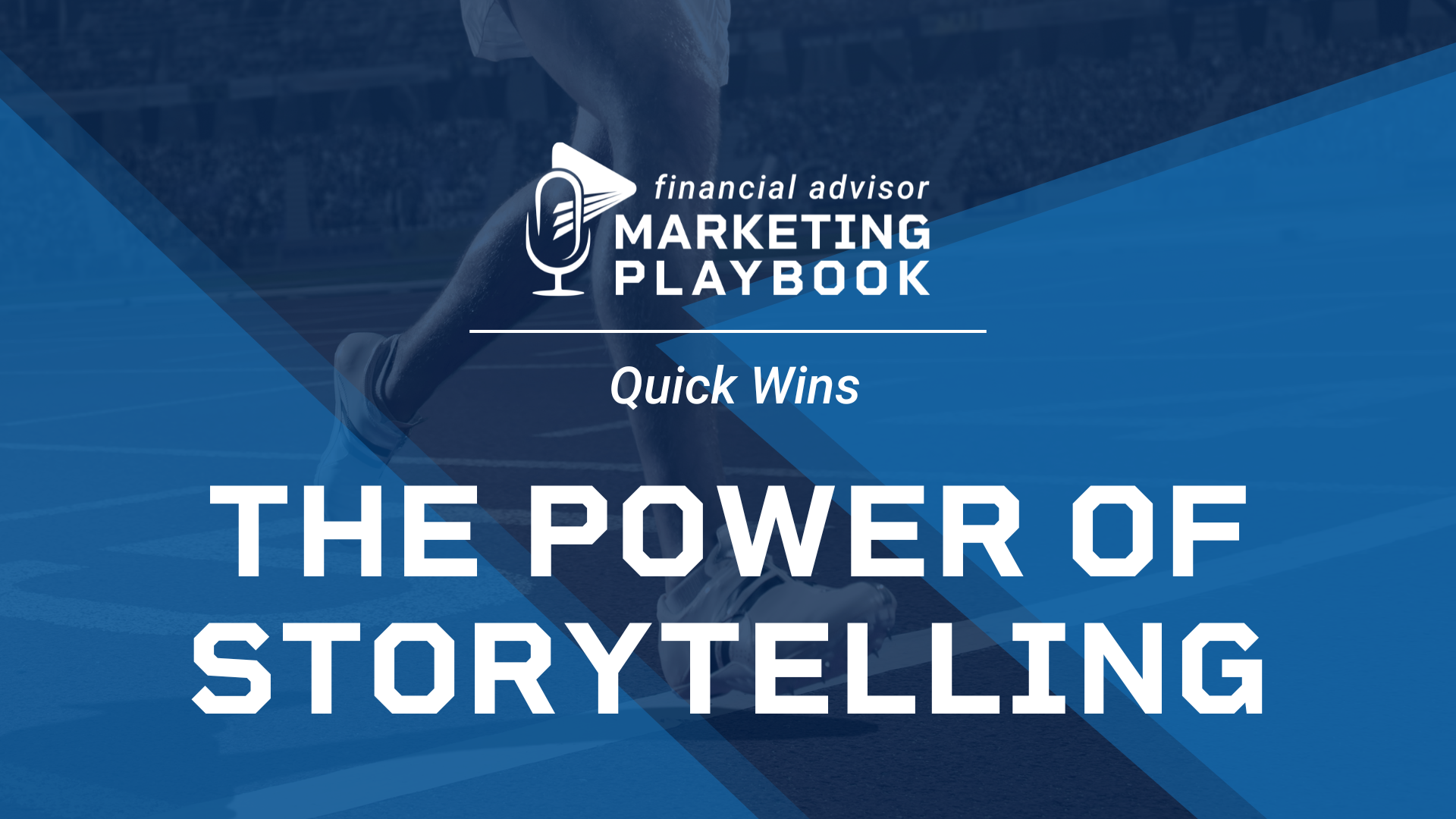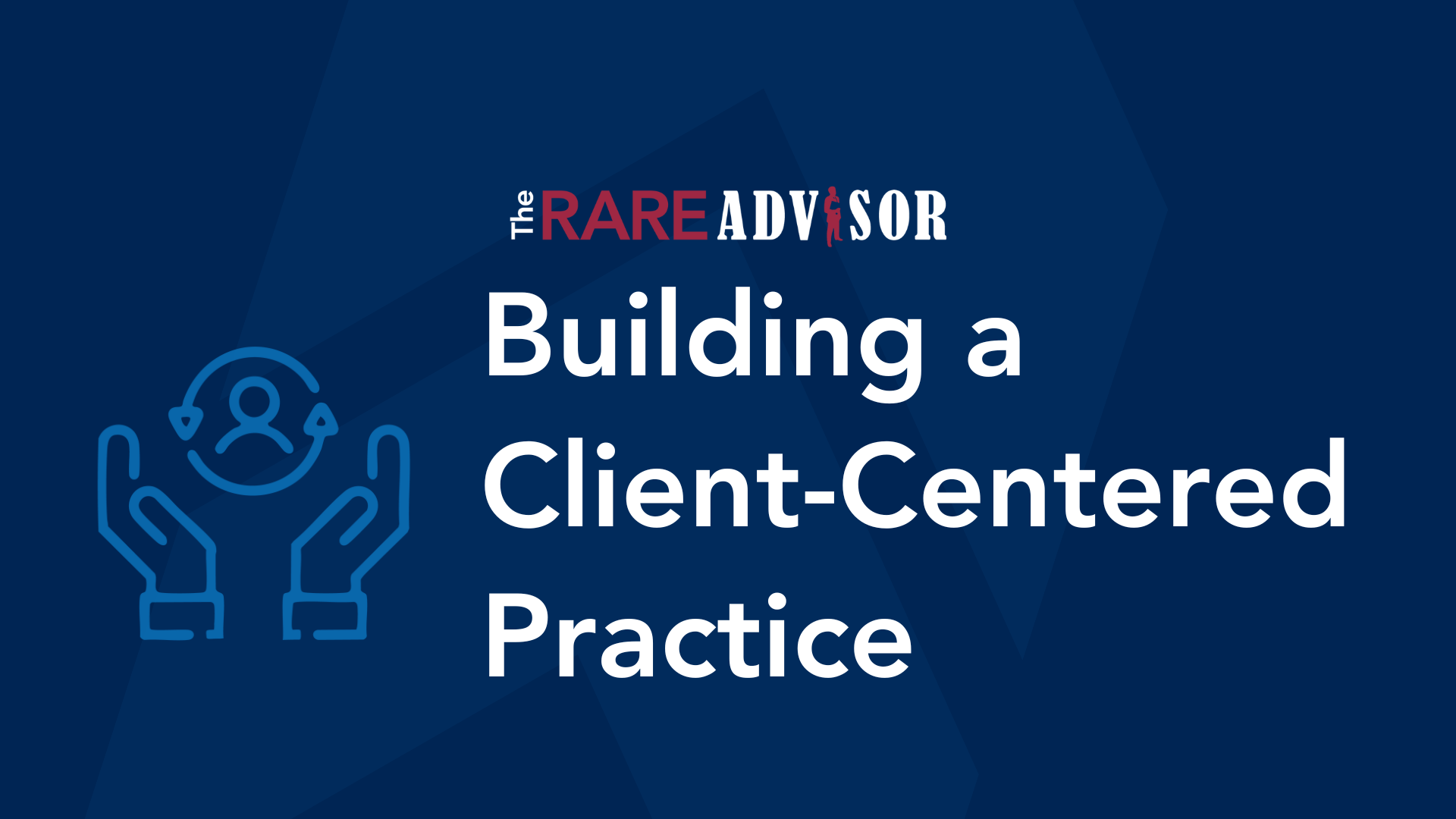Elevate the Client Experience by Ditching the Review Meeting

Tired of the same old financial review meetings? Revolutionize your client communication and stand out from the competition with a simple yet powerful shift: ditch the term "review" and replace it with "strategy and tactical meetings." Learn how this change creates professional contrast, fosters deeper client engagement by focusing on future-oriented planning, and ultimately enhances your client experience.
'Elevate the Client Experience by Ditching the Review Meeting' Transcript
Today we're going to pick up on a topic we were speaking about not too long ago. In a recent RARE video, we had talked about the concept of doing surge meetings. Now, the idea of a surge meeting is just simply taking your review meetings and bundling them together in blocks of time, more often than not in the spring and the fall, to create efficiencies, to free up big chunks of time throughout the course of year, but create more consistency and delivery of your process to your best clients. Now, what I'd like to focus on today is a nuanced concept inside of that process, which really focuses on the actual meeting itself. Now, what meeting are we talking about? I said it just a moment ago, we're talking about the review meeting. Now, we are big believers in the concept of creating permission marketing or professional contrast. These are two ideas of how do we get someone to ask us a question that allows us to continue to tell the story? And so by using unique terms or concepts that maybe aren't normal in the the common-use lexicon that people are used to hearing, it allows us to prompt someone to give us permission to market to them, and by doing so create professional contrast (look and sound different than what they're used to).
This is going to revolve simply around changing the term "review" to what we call Strategy & Tactical Meetings. So, here's what I want you to think in your head: The review meeting is dead. Long live strategy and tactical meetings. I know it sounds silly. It's very simple, but in this context, in this situation, the words matter. Now think about this. Think about the very first time you meet with a prospective client, you go through the process and on the back end of your process, you're onboarding them into what does it look like to be a client of the firm? As part of that process, you're sharing with them, here's my commitment to you as a new client, and here's how often we're gonna meet. Now as part of that process, one of things I would encourage you to say is say this, "Mr. and Mrs. Client, my commitment to you as part of our firm is that we will never have a review meeting." Now think about that. Just that simple statement of saying that we will never do something that they are expecting is going to create that permission marketing. Well, what do mean? What are you talking about? Mr. and Mrs. Client, we don't do review meetings here in our firm. It's in the term, it's in the name, review. Review is all about looking backwards. Here in our firm, it doesn't mean that we're not going to take into account where we've been. But at our firm, we're always looking forward. We're always looking down the road to anticipate those things that are coming that could pull you off track so that we can course correct to always keep you on target for your life's goals. And so here at our firm, we don't do review meetings. We do Strategy & Tactical meetings. Now there's a key element to these meetings. There's the strategy component. The strategy element of our meetings when we get together will be focused on the plan that we've built around your life goals, your needs, your desires, and the plan that we put in place to get you to those. The tactical element of our meetings are going to focus on any course corrections that may be needed based off of outside influences, market volatility, changes in taxes, inflation, changes in regulatory environments, war in Ukraine, any of these things that are outside of our control, but also things that are inside of our control. Maybe your time horizon has changed as far as when you plan to retire. Maybe you buy a second vacation home. Any of the things internal or external to your plan that makes us take a second look and maybe have to make some changes, that's the tactical adjustments that we're going to make when we get together. And so I want you to think, we no longer do review meetings. Think of review meetings as a dirty word. Everybody else does review meetings. Anybody in this industry does review meetings. We're different because when we get together, we do Strategy & Tactical meetings.
Now, that's the idea and the concept, but let's take it a step farther. And we understand that it's not just about creating professional contrast. By creating a consistency in delivery of these meetings, you create an opportunity to competitor-proof your best clients, and you uncover opportunities for new business by doing these types of meetings. But most importantly, in addition to those two, you're also creating the opportunity to stimulate quality introductions. So let's talk about a few best practices. First and foremost, imprint the message. So whether it's a brand new client that you're meeting with for the first time, or as you're bringing them through your process and you're at the point of the onboard, you want to imprint the idea that we do Strategy & Tactical meetings. Don't use the term review. Also, get your team, get your support staff using that term. Use this with both new and existing clients. Secondly, use an agenda. Now, if at the very least use an agenda of sorts, but what I would encourage you is use a printed agenda in these meetings. Having a physical agenda there in the meetings on the table allows you to create tangibility and allows the client to be present in the meeting. There are going to be some standard bullets you're going to to put onto this in agenda. And what I would encourage you to do is standardize your agenda for these S &T meetings and create some variance for spring and fall. So if you're meeting with your best clients in the spring and in the fall, maybe in the spring you're talking about some topics and then the fall maybe you add something like tax because you're preparing for the end of the year. Or maybe you're talking about RMDs or required minimum distributions. But have a couple of small variations.
There are some standard bullets that you should have on every S &T agenda. First and foremost, FORM updates. That is the first bullet that should show up there. When we talk about FORM, it's the idea around family, occupation, recreation, and money. We're going to talk about the money and everything else, but really what this is, is it creates a way for your clients to understand that, what's going on in their lives? What are the things that are important to them? Their why is most important so you want to talk about it first. Naturally, most advisors do this anyway. They have this as part of their conversation, but by putting it on the agenda, you are imprinting in your client's mind that understanding what's going on in their own personal lives is the most important thing. Secondly, second bullet on the agenda is What's New or our Value-Added Services. Now, what I would tell any advisor is that you always want to have something that you can tuck into this area. The idea here is that you want to give your clients the sense that you're always looking for ways to continue to elevate the client experience. You're always looking for ways to create new enhancements. You're not sitting around waiting for the market to come to you. This is an opportunity for you to say that we're always looking down the road. Now, maybe it's not a new enhancement to the process. Maybe it's an event you've got coming up that you want to share with them. Maybe it is something that's changed in your practice. Maybe you've added a new person to the team. Maybe you're looking to add a new person to the team. You can also harken back to your value-added services. This is where you can talk about things like your sounding board - the ability to introduce the introduction as a service you provide and not a favor you ask. You can talk about some of the other value-added services like maybe a virtual vault or a personal financial organizer. This is an opportunity again to point back to all the other benefits of being part of the firm and not just why they're sitting there in front of you, which is their finances. So remember, we're creating this elevated client experience that differentiates you and creates professional contrast from other advisors. Next, the next bullet that you would have on any of these agendas would be the Strategy Update. Now, this is going to incorporate a lot of different things that you do. You could probably have five or six bullets actually under this heading of strategy update. But really, this is the review of the core elements of the plan. All the stuff that you've put in place based on the client's goals and objectives. This is just making sure that everything is where it needs to be and still the plan is valid. Now, if it's not, this is where we move to the next bullet, which would be Tactical Adjustments. These are the course corrections that we might need to make based off of any outside or inside influences. Next bullet. Now, this bullet is a catch-all and this is where you can sub out this bullet in the fall to have this as a place for taxes or RMDs, etc. But I typically would tell advisors to have a bullet for other topics for discussion. Now, the importance of having this bullet, this place, this far down the agenda is this allows for your clients to be heard. This may be a place for you also to pencil in on the agenda if there's another topic that you want to talk about and you can add it right there. But think about it like this. If a client comes into your office for a strategy and tactical meeting and they have something that they want to talk about, but maybe it's not super pressing, but they do want to talk about it. They want to get your opinion. But you know, we have an hour allotted for this meeting. We want to make sure that we get these items really taken care of so that we can get the core elements of what we need to get done for this meeting addressed. So we've added a line so that the client can be heard and we can write right there, we've got it right here on the agenda. We'll make sure we carve out some time to talk about that. Now, obviously, if it's a very pressing matter and requires that you spend time with it immediately, obviously, you'll use your best judgment. But Other Topics for Discussion would be one of the bullets I would put on my agenda. And then last, but not least, is the last bullet that you should have on every agenda that you ever put in front of a client. And it should be one of two things: Where We Go From Here or Next Steps. The idea that we're imprinting to our clients is that our process never ends. It is about our clients understanding that we have a process that is always evolving, always changing, always growing with them as their needs change and evolve. We are as well. And so there's always something else to come. Now, what this leads me to is under this, if I was to put a sub-bullet, which you may do this to help yourself, is schedule the next call.
One of the big things that I am a big believer in is creating efficiencies. And especially if you're doing the surge meetings, it makes sense. Go ahead and schedule the next client meeting, the next Strategy & Tactical, while you have them in front of you. Schedule on the calendar in your surge block that's in the spring or the fall, whatever's to come next. Even if you're not doing surge, here's what I would encourage you. So many advisors I speak to talk about when it's time for that next review meeting - we say Strategy & Tactical - it's someone picks up the phone and you're calling the client, chasing them around, trying to get them on the calendar. And now your calendar is dotted with people all over the place. And here's what I would tell you, pre-schedule the meeting. You have the client in front of you, other businesses do it. Your dentist pre-schedules, you go get your haircut, they pre-schedule your next meeting. There's a comfort in knowing when the next time you're going to see your advisor. So go ahead and put it on the calendar. Give them a little card, let them put it on their calendar, let them plan their lives around it. Tell them, "Mr. and Mrs. Client, if by chance this date ends up not working out, give us a shout and we will adjust it for you. But we wanna make sure that we have carved out time for you". Here's one side benefit of pre-scheduling. What we've found and what we've learned from the advisors that we work with is by pre-scheduling these calls, these clients, more often than not, if there's something that they want to talk about, instead of picking up the phone and calling you, if it's not super pressing, they'll just write it down and they'll wait until their next scheduled meeting to come in and talk to you. No different than what they would do with their own doctor. If it's not super pressing, I'll just wait until my scheduled appointment that's already on the calendar.
And so these are some things that I would encourage you, if you're looking for ways to continue to enhance your process, continue to drive professional contrast, competitor-proof your clients against all the competitive forces out there. You got to stay top of mind and you got to stay in front of them. If you want to continue to drive client advocacy through an elevated client experience, think about adding this simple enhancement to your process. The review meeting is dead. Long live strategy and tactical meetings.
Summary
In the world of financial advising, the review meeting has long been a standard practice. However, in this episode of The RARE Advisor, host Aaron Grady argues that this traditional approach is outdated and fails to truly engage clients or create professional contrast in a sea of sameness. Instead, Aaron speaks to a shift in terminology and focus, advocating for the adoption of "strategy and tactical meetings" as a more dynamic and forward-thinking alternative. This subtle yet powerful change, he contends, can revolutionize client relationships, enhance perceived value, and ultimately drive business growth.
Aaron begins by contextualizing the discussion within the framework of "surge meetings" – the practice of bundling client review meetings into focused blocks of time, typically in the spring and fall. While surge meetings create efficiency, he emphasizes that the quality and impact of the individual meetings themselves are paramount. He zeroes in on the language used to describe these interactions, asserting that the very term "review meeting" carries inherent limitations as review is all about looking backwards. While acknowledging the importance of understanding past performance, he stresses that clients are primarily concerned with their future and achieving their life goals. By framing the conversation as a "review," advisors risk being perceived as backward-looking and less focused on proactive planning. By replacing "review meetings" with "strategy and tactical meetings" advisors can pique client curiosity and prompt them to ask for clarification. This opens the door for advisors to articulate their value proposition and differentiate themselves from competitors who continue to offer standard "reviews."
The phrase "strategy and tactical meetings" immediately conveys a more proactive and comprehensive approach. Strategy implies a focus on the overarching financial plan, aligned with the client's long-term goals, needs, and desires. It suggests a high-level perspective, ensuring that the fundamental roadmap remains relevant and effective. Tactical highlights the advisor's role in navigating the ever-changing landscape of market volatility, tax laws, economic shifts, and even personal life changes. These tactical adjustments ensure the client stays on course despite external or internal influences.
It is important to communicate this shift to both new and existing clients. Imagine the impact of stating, "Mr. and Mrs. Client, my commitment to you as part of our firm is that we will never have a review meeting." This unexpected declaration immediately creates intrigue and an opportunity to explain the firm's forward-thinking philosophy. By emphasizing that the firm is "always looking forward" to anticipate and address potential challenges, advisors position themselves as proactive partners rather than focusing solely on financial performance.
Aaron also highlights best practices for conducting effective Strategy & Tactical meetings. He stresses the importance of "imprinting the message" by consistently using the new terminology with both clients and internal team members. This reinforces the firm's commitment to this differentiated approach. Another crucial element is the use of a printed agenda. He advocates for a tangible agenda as a way to create presence and keep the client engaged. He suggests standardizing the agenda for these S&T meetings with slight variations for spring and fall to accommodate seasonal considerations like tax planning. Key components of a successful S&T meeting agenda should include:
- FORM Updates (Family, Occupation, Recreation, Money): This initial point emphasizes the client's life and priorities beyond just their finances. By starting with what's important to them, advisors reinforce that their well-being is central to the planning process.
- What's New / Value-Added Services: This section provides an opportunity to showcase ongoing efforts to enhance the client experience, highlight new services or team members, or reiterate existing value-added offerings like financial planning tools or educational resources. This combats the perception of stagnation and demonstrates continuous improvement.
- Strategy Update: This segment focuses on reviewing the core elements of the client's financial plan, ensuring it remains aligned with their goals and objectives.
- Tactical Adjustments: This crucial section addresses any necessary course corrections due to external market forces or internal life changes. It highlights the advisor's proactive role in navigating complexities.
- Other Topics for Discussion: This agenda item provides a space for clients to raise their own questions or concerns, ensuring they feel heard and valued. It also allows the advisor to introduce additional relevant topics.
- Where We Go From Here / Next Steps: This final point reinforces the ongoing nature of the relationship and the continuous evolution of the financial plan.
Crucially, under "Next Steps," Aaron strongly recommends scheduling the next Strategy & Tactical meeting while the client is still in the office. This proactive approach eliminates the often time-consuming and inefficient process of chasing clients for appointments. By pre-scheduling, advisors demonstrate organization, respect for the client's time, and create a sense of consistent engagement, mirroring practices in other professional service industries.
In conclusion, Aaron argues that the traditional "review meeting" is a relic of the past that fails to capture the dynamic and forward-looking nature of effective financial advising. By embracing the language and mindset of "strategy and tactical meetings," advisors can create professional contrast, deepen client engagement by focusing on their future and adapting to change, enhance the perceived value of their services, and ultimately foster stronger, more enduring client relationships that are resistant to competitive pressures. This seemingly simple shift in terminology, coupled with a structured and client-centric meeting agenda, represents a powerful step towards elevating the client experience and future-proofing your advisory practice.
--
The RARE Advisor is a business model supercharged by Recurring And Repeatable Events. With decades of experience coaching successful advisors, your host, along with other leaders in the industry, discusses what it takes to grow a successful practice. With the aim of helping financial professionals and financial advisors take their business to the next level, this podcast shares insights and success stories that will make a real impact. Regardless of the stage of your practice, The RARE Advisor will provide thoughtful guidance, suggestions for developing systems and processes that work, and ideas for creating an authentic experience for your clients.
The RARE Advisor is also a podcast! Subscribe today via Apple Podcasts, Google Podcasts, or your preferred podcast listening service for easier on-the-go listening.
Author Info

Aaron Grady is the Advisor Consulting Director with USA Financial. He brings more than 18 years of Financial Services industry experience...
Related Posts

The Power of Storytelling: 3 Essential Stories Every Financial Advisor Needs
In this episode of Financial Advisor Marketing Playbook, Mark Mersman reveals how storytelling can transform your marketing and client relationships. Learn the three foundational stories every advisor needs: your origin story to build trust, your client transformation story to demonstrate results and empathy, and your philosophy story to define your beliefs and differentiate your brand. Discover practical tips for crafting these narratives and integrating them into your website, meetings, and marketing strategy.

Building a Client-Centered Practice: Insights from Duncan MacPherson & Pareto Systems
In this episode of the Rare Advisor, host Aaron Grady sits down with Duncan MacPherson of Pareto Systems to unpack the “Always On” client experience from The Blue Square Method—showing financial advisors how to move from personality-driven to process-driven, scalable firms. You’ll learn the four quadrants (Onside, Onboard, Ongoing, Onward), why a documented fit process and onboarding sequence create professional contrast, how the 12-4-2 service model competitor-proofs relationships, and why systematizing moments of truth builds advocacy and referrals. We cover turning know-how into intellectual property (playbooks/SOPs), becoming “fee-worthy” and referable, leveraging the Pareto principle for AAA clients, and shifting from B2C to B2B growth.

From SEO to AEO: How Financial Advisors Can Rank in ChatGPT & Google AI
In this episode of The Financial Advisor Marketing Playbook, Mark Mersman explores the fast-emerging concept of Answer Engine Optimization (AEO)—how advisors can adapt their websites and content strategies for the AI-driven search era. As traditional SEO gives way to AI search tools like ChatGPT and Google’s AI Overviews, Mark explains what this shift means for financial advisors and how to stay visible in a world where consumers ask questions directly to AI instead of clicking through search results. He shares practical, actionable steps—like writing with user intent in mind, expanding website depth and breadth, structuring Q&A sections, and earning external credibility—to help advisors ensure their content is surfaced in AI-powered search results. If you want your firm to show up when prospects ask financial questions to AI, this episode is a must-watch.

The Power of Storytelling: 3 Essential Stories Every Financial Advisor Needs
In this episode of Financial Advisor Marketing Playbook, Mark Mersman reveals how storytelling can transform your marketing and client relationships. Learn the three foundational stories every advisor needs: your origin story to build trust, your client transformation story to demonstrate results and empathy, and your philosophy story to define your beliefs and differentiate your brand. Discover practical tips for crafting these narratives and integrating them into your website, meetings, and marketing strategy.

Building a Client-Centered Practice: Insights from Duncan MacPherson & Pareto Systems
In this episode of the Rare Advisor, host Aaron Grady sits down with Duncan MacPherson of Pareto Systems to unpack the “Always On” client experience from The Blue Square Method—showing financial advisors how to move from personality-driven to process-driven, scalable firms. You’ll learn the four quadrants (Onside, Onboard, Ongoing, Onward), why a documented fit process and onboarding sequence create professional contrast, how the 12-4-2 service model competitor-proofs relationships, and why systematizing moments of truth builds advocacy and referrals. We cover turning know-how into intellectual property (playbooks/SOPs), becoming “fee-worthy” and referable, leveraging the Pareto principle for AAA clients, and shifting from B2C to B2B growth.

From SEO to AEO: How Financial Advisors Can Rank in ChatGPT & Google AI
In this episode of The Financial Advisor Marketing Playbook, Mark Mersman explores the fast-emerging concept of Answer Engine Optimization (AEO)—how advisors can adapt their websites and content strategies for the AI-driven search era. As traditional SEO gives way to AI search tools like ChatGPT and Google’s AI Overviews, Mark explains what this shift means for financial advisors and how to stay visible in a world where consumers ask questions directly to AI instead of clicking through search results. He shares practical, actionable steps—like writing with user intent in mind, expanding website depth and breadth, structuring Q&A sections, and earning external credibility—to help advisors ensure their content is surfaced in AI-powered search results. If you want your firm to show up when prospects ask financial questions to AI, this episode is a must-watch.

